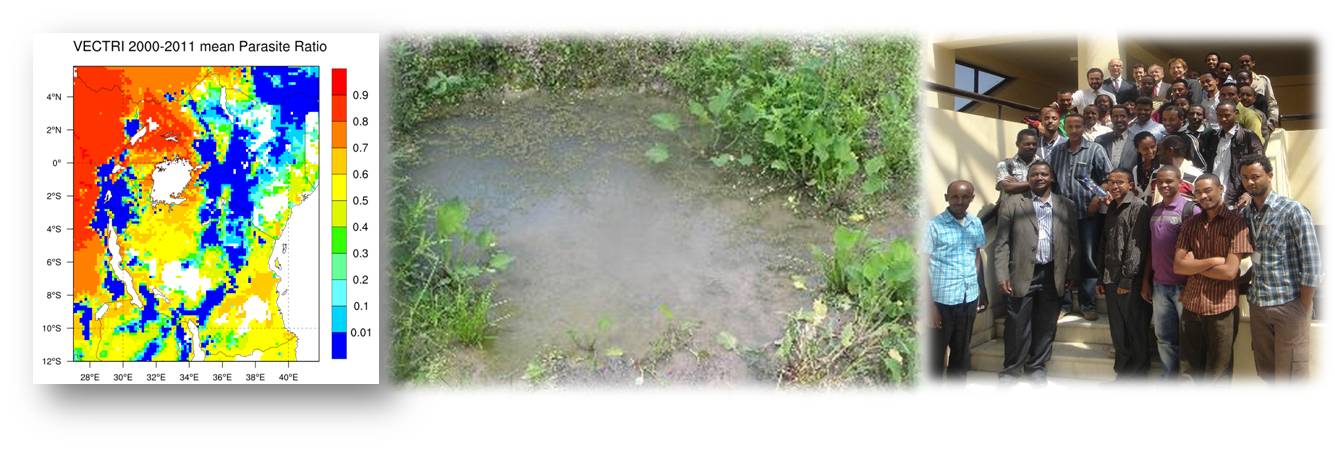Publications using the VECTRI model
| [1] | Ruchi Singh Parihar, Prasanta Kumar Bal, Vaibhav Kumar, Saroj Kanta Mishra, Sandeep Sahany, Popat Salunke, Sushil Kumar Dash, and Ramesh Chand Dhiman. numerical modeling of the dynamics of malaria transmission in a highly endemic region of India. Science Reports, 9(1):1--9, 2019. |
| [2] | A. M. Tompkins, F. J. Colón-González, F. Di Giuseppe, and D. B. Namanya. Dynamical malaria forecasts are skillful at regional and local scales in uganda up to four months ahead. GeoHealth, 3:https://doi.org/10.1029/2018GH000157, 2019. [ http ] |
| [3] | A. M. Tompkins and M. C. Thomson. Uncertainty in malaria simulations due to initial condition, climate and malaria model parameter settings investigated using a constrained genetic algorithm. Plos One, 13:10.1371/journal.pone.0200638, 2018. |
| [4] | A. M. Tompkins, Rachel Lowe, Hannah Nissan, Nadége Martiny, Pascal Roucou, Madeleine C. Thomson, and Tetsuo Nakazawa. Predicting climate impacts on health at sub-seasonal to seasonal timescales. In A. W. Robertson and F. Vitart, editors, The gap between weather and climate forecasting: sub-seasonal to seasonal prediction, page 9780128117149 . Elsevier, 2018. [ http | .pdf ] |
| [5] | Ernest Asare and Leonard Amekudzi. Assessing climate driven malaria variability in Ghana using a regional scale dynamical model. Climate, 5(1):20, 2017. |
| [6] | J. Leedale, A. M. Tompkins, C. Caminade, A. E. Jones, G. Nikulin, and A. P. Morse. Projecting malaria hazard from climate change in eastern Africa using large ensembles to estimate uncertainty. Geospat. Health, 11:DOI: 10.4081/gh.2016.393, 2016. [ http | .pdf ] |
| [7] | F. J. Colón-González, A. M. Tompkins, R. Biondi, J. P. Bizimana, and D. B. Namanya. Assessing the effects of air temperature and rainfall on malaria incidence: an epidemiological study across Rwanda and Uganda. Geospat. Health, 1:DOI: 10.4081/gh.2016.379, 2016. [ http ] |
| [8] | E. Asare, A. M. Tompkins, and A. Bomblies. Evaluation of a simple puddle breeding site model for malaria vectors using high resolution explicit surface hydrology simulations. Plos One, 11:http://dx.doi.org/10.1371/journal.pone.0150626, 2016. [ http ] |
| [9] | Ernest O. Asare, A. M. Tompkins, Leonard K. Amekudzi, and Volker. Ermert. A breeding site model for regional, dynamical malaria simulations evaluated using in situ temporary ponds observations. Geospat. Health, 11:DOI:10.4081/gh.2016.390, 2016. [ www: ] |
| [10] | Ernest O. Asare, A. M. Tompkins, Leonard K Amekudzi, Volker. Ermert, and Schuster R. Mosquito breeding site water temperature observations and simulations towards improved vector-borne disease models for Africa. Geospat. Health, 11:DOI:10.4081/gh.2016.391, 2016. [ www: | www: ] |
| [11] | A. M. Tompkins, F. Di Giuseppe, F. J. Coloń-González, and D. B. Namanya. A planned operational malaria early warning system for Uganda provides useful district-scale predictions up to 4 months ahead. In J.Shumake-Guillemot and L.Fernandez-Montoya, editors, Climate services for health: Case studies of enhancing decision support for climate risk management and adaptation, pages 130--131. WHO/WMO Geneva, 2016. [ www: ] |
| [12] | A. M. Tompkins and L. Caporaso. Assessment of malaria transmission changes in Africa due to the climate impact of land use change using CMIP5 earth system models. Geospat. Health, 11:doi:10.4081/gh.2016.380, 2016. [ http ] |
| [13] | A. M. Tompkins, L. Larsen, N. McCreesh, and D. M. Taylor. To what extent does climate explain variations in reported malaria cases in early 20th century Uganda? Geospat. Health, 11:10.4081/gh.2016.407, 2016. [ http | .pdf ] |
| [14] | A. M. Tompkins and F. Di Giuseppe. Potential predictability of malaria using ECMWF monthly and seasonal climate forecasts in Africa. J. Appl. Meteor. Clim, 54:521--540, 2015. [ http | .pdf ] |
| [15] | Franziska Piontek, Christoph Müller, Thomas AM Pugh, Douglas B Clark, Delphine Deryng, Joshua Elliott, Felipe de Jesus Colón González, Martina Flörke, Christian Folberth, Wietse Franssen, others, and Tompkins A. M. Multisectoral climate impact hotspots in a warming world. Proc. Nat. Acad. Sci., page doi:10.1073/pnas.1222471110, 2014. [ http ] |
| [16] | C. Caminade, S. Kovats, J. Rocklov, A. M. Tompkins, A. P. Morse, F. J. Colón-González, H. Stenlund, P. Martens, and S. J. Lloyd. Impact of climate change on global malaria distribution. Proc. Nat. Acad. Sci., 111(9):3286--3291, 2014. [ http ] |
| [17] | A. M. Tompkins and V. Ermert. A regional-scale, high resolution dynamical malaria model that accounts for population density, climate and surface hydrology. Malaria Journal, 12:doi:10.1186/1475--2875--12--65, 2013. [ http | .pdf ] |
This file was generated by bibtex2html 1.99.
